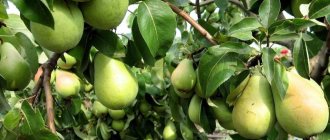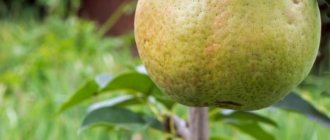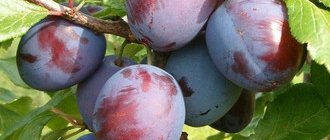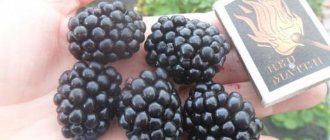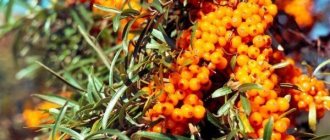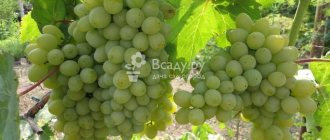Description of the gooseberry variety Candy
The erect plants of the variety are low, up to 1 m, very dense, with a superficial root system that goes deep to 30 cm. Bushes of the Candy variety are formed from thin or medium-thick shoots.
Young branches are green, slightly curved, without pubescence. Only the lower shoots of the Candy gooseberry are rarely equipped with thin, medium-length brown thorns. The leaf buds of the variety are dark brown, conical, and the fruit buds are more rounded and lighter in color. Five-lobed leathery leaves of regular size, slightly wrinkled, hairless. Toothed leaf blades are slightly curved along the central vein, attached to the branches with a green petiole of moderate thickness and length. Candy gooseberry inflorescences consist of 1-2 goblet-shaped flowers with pale pink sepals, which belong to a species with a high degree of self-fertility. Round-oval berries of medium and large size, weighing 3-6 g, are held on a green stalk. The fruits on the branches are almost uniform in size, as can be seen in the video and photo of the Candy gooseberry.
The delicate skin is moderately dense, slightly pubescent, rich pink-red in color. Light veins are visible on the berries of the Candy variety. The pulp is transparent greenish, with a moderate amount of seeds.
The delicious taste of gooseberries of the Candy variety is, according to reviews, balanced, pleasant sweet and sour, with a predominance of sweetness. In percentage terms, the composition of sugars reaches 8.8%, according to other sources - 12%, acids - 1.1%, or 2%, as well as 16% of dry matter. 100 g of Candy berries contain 55.2 mg of ascorbic acid. The tasting rating of the dessert variety is high – 5 points. The taste and composition of gooseberry berries varies depending on the growing conditions: soil nutrition, sunlight, summer temperature.
Comment! According to experts, Candy gooseberries are among the sweetest.
Harvest and storage
English yellow gooseberry fruits begin to ripen in the third decade of July. The variety is productive, the average yield of one bush is 12–15 kg. Fruiting is extended over time, so harvesting is carried out in several stages.
When ripe, English yellow gooseberry fruits do not fall off
Ripe berries can be stored for 4–5 days at a temperature of +2 °C. For longer storage, gooseberries are harvested 7–10 days before they are fully ripe. Such berries are stored at a temperature of 0 degrees and high humidity for a month, and at a temperature of -2 °C the period increases to 3 months.
For transportation, the fruits are packaged in small wooden containers lined with paper. 2.5–3 kg of berries are poured into one container.
English yellow gooseberry is a dessert variety. It is consumed fresh and also used for preparing various preparations. It is suitable for heat treatment. The berries make homemade wine especially tasty.
Harvesting and storage
The African gooseberry harvest period falls in July and lasts approximately a month as the fruits ripen. Berries need to be picked in dry weather so that they do not lose their appearance and subsequently spoil quickly. It is advisable to collect in a small container.
You can store the harvest in a cool, dry room at a temperature of 0°C, placing whole and undamaged berries in low, paper-lined, well-dried boxes. In such conditions, the fruits can be stored for up to 1.5 months.
You will be interested to read about the beneficial properties of gooseberries for the human body.
Characteristics of the variety
The description of the Candy gooseberry states that the berries will ripen in the middle period. Some gardeners even classify the variety as a late-ripening species of shrubs, which depends on the regions and the beginning of the growing season in different years.
Drought resistance, frost resistance
The thin and shallow roots of the Candy berry bush do not tolerate long dry periods, which are especially undesirable during flowering. The soil should be moderately moist, not too dry. Gooseberries of the Candy variety are winter-hardy and tolerate frosts down to -29 °C. Sometimes it does not freeze even at lower thermometer readings, if they last for 1-2 days. The winter hardiness of a berry bush depends on the preparation of the plant for cold weather:
- degree of saturation with nutrients using fertilizing;
- moisture-recharging irrigation;
- autumn weather - with a warm and fine autumn, the gooseberry smoothly goes into a dormant state.
Important! The characteristics of winter weather play a significant role. Repeated thaws and frosts significantly weaken even a resistant variety.
Fruiting, productivity
The Candy bush produces from 1.8 to 6.5 kg of sweet dessert berries, which depends on the conditions in which the plant develops. Although the variety is resistant to cold, a temperate climate is more favorable for it. The Candy berry bush is responsive to additional nutrition and timely watering. Gooseberry fruiting begins in the second year of planting. The variety's berries ripen from mid-to-late June, with the main harvest occurring in July-August. The fruits of Candy are firmly attached to the shoots and can hang ripe on the bush for two to three weeks without losing their vitamin properties. In the regions recommended for growing, the berries do not suffer from scorching sun rays.
Attention! The berries of the Candy variety taste good even when unripe.
Application area
The berries withstand transportation quite well if they were carefully picked during harvest. Candy gooseberry fruits are stored for 2 weeks in household refrigerators, and up to a month in industrial refrigerators. Delicious berries are consumed fresh, because they have a rich vitamin composition. Excess production is used for sweet homemade preparations: preserves, jam, compote. Natural marmalade is prepared from gooseberries, whose fruits contain a lot of pectin. Dense, intact berries of the Confectionery variety look good after freezing and are used for filling or compotes.
Variety resistance to pests and diseases
Candy gooseberry is mildly affected by powdery mildew and anthracnose. The variety is more susceptible to septoria. The plant has many pests. In order for the bush to develop well, preventive treatments must be carried out in the spring.
Advantages and disadvantages of the variety
According to gardeners, the Candy gooseberry has many advantages, which distinguishes it from other varieties:
- sweet taste of attractive berries;
- good productivity, which is based on sufficient self-fertility;
- absence of thorns in the upper tier of branches;
- winter hardiness;
- low susceptibility to characteristic diseases of the species - powdery mildew and anthracnose.
But there are some comments about the variety:
- demanding on soils;
- insufficient immunity to many other diseases.
Reproduction
Amber gooseberry belongs to varietal plants, but in everyday life the seed propagation method is not used as it is too troublesome. To obtain high-quality planting material, all types of vegetative propagation are used, which are simple and reliable, and fruiting will begin within 1 year after planting:
- Dividing the bush: with timely planting in the fall, fruiting occurs in the next season.
- Cuttings: A large number of cuttings can be grown from cuttings. The method requires regular monitoring: frequent watering, spraying, fertilizing.
- “Chinese” method: they dig in a gentle branch and in the spring they get a strong daughter plant - a cutting of the mother bush.
The last method is simple and accessible even to novice gardeners. From 1 bush you can safely grow 2-3 cuttings and for the next years your family will be provided with delicious berries and raw materials for winter preparations - compotes, jam, marshmallows and marmalade.
Reproduction methods
Gooseberries are propagated by cuttings and layering. In the first case, in September-October, on the strongest shoots, you need to cut off the top 10–12 cm long. Dig a shallow hole in the ground, place the cuttings in it at an angle, leaving 2 buds on the soil surface. Compact the earth.
Next year the cuttings will take root and can be planted in a permanent place.
In the second case, in early spring, before the buds bloom around the bush, you should dig a shallow furrow, bend the young branches to it, and fix it to the ground. After some time, new shoots will appear from the side buds. When they reach a length of 15 cm, they need to be sprinkled with soil on top.
In the fall, when they take root, the cuttings can be replanted.
Characteristics and description
The variety is resistant to winter frosts. Boasts high productivity. From one bush you can collect up to 6.5 kg of gooseberries.
“Konfetnoe” bushes are dense, medium-sized and erect. Young shoots are elastic, thin, curved, and green. At the bottom of the bush there are rare, single thorns. There are also brown dense buds on the shoots. The leaves are green, with a glossy surface.
Fruiting begins in the second year. Ripe large fruits weigh up to 6 g and contain a large amount of useful substances: many sugars, vitamins, iron, acids. The skin is thin, with a slight roughness. Fruits of universal use. They make excellent compotes, jams, marmalade, marshmallows and even wine.
The main advantage is the ability to use it at any stage of maturity.
If you have papillomas, read - before they are removed! This gets rid of parasites in 2 days and forever...Read more...
Botanical description of African gooseberry
African gooseberry is a medium-sized, high-yielding, winter-hardy, early-fruiting and thornless shrub.
The shrub begins to bear fruit in the second year after planting. From one bush you can collect up to twelve kilograms of berries. The fruits are black in color , medium in size and oval in shape. The taste of the fruit is excellent, sweet and sour, slightly reminiscent of the taste of currants. Harvesting will not be difficult, since there are no thorns on the bush. The berries make excellent jam, compote, jam and jelly.
African gooseberry is not afraid of powdery mildew and aphids, which pleases gardeners. To prevent the yield of berry bushes from falling, it is necessary to fertilize, water, pruning and spraying in a timely manner.
Diseases and pests, how to deal with them
English gooseberries are resistant to almost all diseases, but powdery mildew is not on their list. For prevention, it is recommended in the spring, before the buds open, to treat the bush with Nitrafen.
Also, after each pruning, the branches are treated with Bordeaux mixture. After the plant has been watered, be sure to dig up the soil. In autumn, get rid of weeds and fallen leaves.
Gooseberries of this variety are susceptible to attacks by aphids, moths and spider mites. It is easier to carry out prevention and treat the plant with Carbofes than to fight pests. Be sure to destroy fallen leaves and dead parts of the plant, and re-treat the plant with Karbofes in the summer.
a brief description of
The gooseberry variety with amber berries has practically no disadvantages.
Advantages of the variety
- High yield.
- Excellent taste of fruits.
- Gooseberries of the Yantarny variety are in demand on the market - they have a beautiful appearance and tolerate transportation well.
- Unpretentious bushes do not require repeated treatments against fungal diseases and shelter for the winter.
- The high adaptive properties of the variety are manifested in almost 100% survival rate of seedlings.
Disadvantages of the variety
Spreading branches fall to the ground under the load of the harvest - a fruit-bearing bush requires growing on a support.
Even the disadvantage of a variety is the other side of the advantage. An impressive list of advantages against the backdrop of an insignificant disadvantage arouses quite understandable interest among summer residents in the Yantarny variety - purchasing seedlings, planting and growing them.
Various diseases and insect pests
We talked about the fact that the variety has good immunity to many diseases and pests. But it is susceptible to anthracnose. A characteristic sign of this rapidly spreading disease is the appearance of brown spots on the foliage.
As soon as you notice this phenomenon, you must immediately treat the bush with a 1% solution of Bordeaux mixture.
Gooseberries of the African variety have long managed to win the love of many summer residents throughout the country. Reviews about the African gooseberry are overwhelmingly positive due to its ease of care, large berries, and wonderful taste characteristics, which allow the berries to be consumed fresh, or to prepare various preparations for the winter.
Characteristics of the variety
According to the description and reviews, Amber gooseberries are considered an unpretentious variety that does not require special skills from gardeners. It has decent characteristics that allow even completely inexperienced summer residents to obtain high yields.
Drought resistance, frost resistance
Amber tolerates drought well and is frost-resistant. According to reviews and experience of farmers, the Yantarny gooseberry variety tolerates temperatures down to -40 °C. The roots tolerate frost well, only the branches can freeze if the covering is careless. But the consequence of a long drought will be small fruits. Therefore, if it is possible to organize watering, the berries will grow large and juicy.
Fruiting, productivity
Depending on the growing region, the ripening period of berries shifts. The warmer the climate, the earlier the fruits ripen. In the southern regions, harvesting begins in the first week of June, and in the east or west later: it is either the middle of the month or August. In the north, gooseberries reach fruiting maturity from mid-July to September.
The Yantarny variety begins to bear fruit already in the second year after planting. It is characterized by longevity and the ability to produce crops throughout the entire period. You can collect gooseberries from bushes that are up to 40 years old. At the same time, the berries retain their size and do not become smaller.
The variety is not prone to shedding of berries. Gooseberry fruits can remain on the branches for a long time.
Important! If there is excess moisture, Yantarny berries are susceptible to cracking.
This must be taken into account in years with wet weather or prolonged rainfall.
If you create a favorable agricultural background for the bushes, then one plant will produce up to 10.5 kg of ripe gooseberries. This is a record value; on average, gooseberries produce 7-8 kg per bush. On an industrial scale, harvesting begins 7 days before full maturity. In this state, the berries are not damaged during transportation. The indicator increases if agrotechnical requirements are met, regular pruning, and careful care. The variety tolerates transportation well without losing its qualities and presentation.
Application area
The main use of Amber gooseberries is fresh consumption. The berry is liked by children and adults. Breeders worked to create a dessert variety, so the characteristics of the Yantarny gooseberry are excellent for culinary delicacies. Jams, compotes, confitures, and “royal” jam are prepared from it. The dense pulp allows you to prepare rich preparations and transport the harvest over long distances. In addition to berries, gooseberry leaves are often used to prepare vitamin teas.
Variety resistance to pests and diseases
For gardeners, the quality of resistance of gooseberries of the Yantarny variety to many fungal infections is valuable. The plant is not affected by fruit rot or “spheroteca”. Gardeners note that the plantings are almost not attacked by gooseberry aphids.
Advantages and disadvantages of the variety
The characteristics of a culture are usually divided into positive and not so positive. This is necessary in order to immediately know the effectiveness of the selected variety. Amber gooseberry has the following advantages:
- Long fruiting time.
- Does not require pollinators.
- The berries do not fall off for a long time after ripening.
- During transportation, gooseberry fruits do not crack and retain their commercial and taste characteristics in full.
- High yield of the Yantarny variety, long fruiting age.
- Resistance to fungal infections.
- Frost resistance of the variety.
- Dessert taste, honey aroma of ripe gooseberries.
Gardeners consider the disadvantages of the Amber variety to be:
- Spreading and thickening of bushes. This requires regular pruning, installing supports or tying up branches.
- Very sharp thorns. Despite their small number, they can cause a lot of difficulties when caring for gooseberries.
- Violation of the rules of culinary processing leads to the overcooking of the fruits of the variety. First of all, this concerns the duration of exposure to high temperatures.
- Some note the presence of acid in the taste of berries as a disadvantage.
The list can be called short. After all, each gardener has his own preferences and experience.
Rules for caring for African gooseberries
- With the onset of autumn, you need to fertilize. To do this, rotted manure, potassium chloride, and superphosphate are added to the soil.
- After autumn fertilizing, the soil needs to be loosened.
- The second feeding is carried out in the spring. It is better that the feed is liquid. It can be prepared from ammonium nitrate and mullein.
- Pruning of the bush should begin in the second year after planting. Remove dry, diseased and weak shoots. Do not forget to thin out the bush; it should not be dense, as this can reduce the yield.
- To prevent anthracnose from infecting the shrub, spray it with boron mixture twice a season.
How and when to plant
For planting, it is advisable to choose the most illuminated place, protected from sharp gusts of wind. To ensure that the harvest is always good, shading of bushes by trees and nearby buildings is unacceptable. It is best to plant gooseberries along the fence on the south side. This arrangement has another definite advantage - providing support - trellises for tall bushes.
Landing algorithm:
- Gooseberry Rodnik, like this variety, loves fertile soil, so before planting it is necessary to enrich its composition . To do this, mineral and organic fertilizers, humus and peat are applied. Acidic soil is limed to a neutral or slightly acidic level.
- It is necessary to prepare the hole in advance . It should be approximately 60x30 centimeters in size. The root system of gooseberries, as a rule, is located shallow.
- Humus mixed with superphosphate (about 50 grams) and wood ash (half-liter jar) is poured into the bottom of the hole.
- The seedling is placed vertically upward, covered with earth and compacted tightly . After planting, it is necessary to water the plant well and mulch the soil at the roots.
- The seedling must be cut at the level of the fifth bud, leaving no more than 15 - 20 centimeters of the trunk above the ground surface. But this description will help you understand how to plant Prune gooseberries correctly.
In the video - planting gooseberries:
Due to the good viability of the seedlings, planting can be carried out throughout the summer. This quality allows you to successfully grow “Amber” gooseberries in any region of the Middle Zone.
How and when to plant Amber gooseberries
To get a significant harvest of berries, you must adhere to the recommended growing technology. Any deviation from this technology is guaranteed to lead to a decrease in yield and a decrease in the intensity of development of the gooseberry bush.
Seedling preparation
Particular attention must be paid to the correct selection of high-quality, healthy seedlings.
First of all, you need to choose seedlings from certified gardening stores or from well-known amateur gardeners.
Planting material of this variety should be no more than two years old.
A standard seedling must have 3-4 well-formed shoots at least 30 cm long. The root system must be at least 25 cm long and consist of a large number of viable dark-colored roots.
A day before planting the seedling in a permanent growing place, it is necessary to cut off the tops of the shoots by 1-2 cm and place the seedling in water. It is advisable to add the drug Kornevin (4-5 ml per 3-4 liters of water) to this solution to increase the intensity of the formation of a new root system. It is also advisable to trim the tips of the roots by 1-2 cm. All damage on the surface of the shoots should be covered with garden varnish.
Features of planting shrubs
Seedlings of this crop can be planted throughout the entire growing season from early spring to late autumn. According to experienced gardeners, the most optimal planting time is autumn, namely September. When planted at this time, the young plant will be able to take root quite well before the onset of the first autumn frosts, which will ensure normal overwintering in the future.
For satisfactory development of gooseberries, you should choose a site that is well lit and with reliable protection from gusty winds. It is very important that the soil in this area is slightly acidic or neutral with the presence of a significant amount of nutrients. For the normal supply of moisture and oxygen to the plant bark system, it is necessary that the soil has a loose structure.
Planting process
2-3 weeks before planting, the area should be dug or plowed to a depth of 27-29 cm. After this, until planting, the soil surface should be kept loose and free of weeds. It is very important to level the soil surface for future high-quality watering and care of gooseberry bushes. As noted earlier, Amber gooseberries can be planted throughout the season.
The most important stage of planting is preparing the planting hole. It is very important that the dimensions of this pit fully correspond to the parameters of the root system of the seedling of a given crop. When choosing a location for a planting hole, you need to decide what planting pattern will be used. Since this variety has a fairly high above-ground part, it is necessary that the planting pattern be at least 2 x 2 m.
On average, a planting hole has a width and depth of about 48-50 cm. In the process of digging such a hole, fertile and less fertile soil must be laid separately. A properly dug hole should have smooth and vertical walls. After digging a hole, it is fertilized with 8-9 kg of rotted manure, 30-40 g of potassium salt and 120-150 g of superphosphate. 7-8 kg of fertile soil are poured on top of all these fertilizers and mixed thoroughly.
Before planting gooseberries, pour 7-9 liters of water into the planting hole. After waiting for the water to be completely absorbed, a seedling is placed in the center of the hole and the root system is covered with fertile soil. In this case, the root collar should be located 4-5 cm below the soil surface. We have already written how to determine the root collar of a seedling, we recommend reading it. After planting is completed, a watering hole is made around the seedling.
Landing
Planting gooseberries of the African variety consists of a number of activities, which include choosing the right planting location, choosing planting material, acceptable timing, etc.
Video: Planting gooseberries
Deadlines
Gooseberry bushes can be planted in both spring and autumn. It is best to plant in the autumn, 4–6 weeks before the onset of frost, when the root system is saturated with useful substances and is growing well. The spring period is less favorable, since the buds on the bushes of this berry crop bloom very early, and if planting is done at the wrong time, the plant may get sick, which will negatively affect the quality and quantity of the harvest.
We recommend that you learn more about how, where and when to plant gooseberries.
Choosing a suitable location
The most suitable place for planting African gooseberry seedlings must meet the following requirements:
- the area should be well lit and located on a hill;
- groundwater occurrence - no higher than 1.5 m;
- soil - loamy or sandy loam;
- the plant must be protected from drafts and strong winds.
Selection and preparation of planting material
The choice of seedlings also plays an important role in the speed of their establishment in a new place:
- planting material should be 1–2 years old;
- root system - well developed;
- It is recommended to purchase seedlings from trusted suppliers or special nurseries;
- Before planting, it is advisable to soak the planting material in a special solution that stimulates root growth.
Planting scheme
When planting seedlings in a permanent place, you need to adhere to the following scheme:
- Clear the area of weeds in advance, dig deep, and apply organic fertilizers.
- 2-3 weeks before planting, dig a hole 50 cm deep and 50 cm wide.
- Leave the distance between plants at 1.5–2 m.
- Mix the top layer of soil with 1 bucket of manure or compost, 100 g of wood ash, 50 g of double superphosphate, 40 g of potassium sulfur.
- Pour the nutrient mixture into the hole in the form of a tubercle.
- Shorten the young seedling, leaving 5 buds on each shoot.
- Place the bush on a hillock at a slight slope, straighten the roots.
- The root collar should be 2–3 cm below ground level.
- Sprinkle the roots, fill the hole with earth, gradually compacting it.
- Pour in 1 bucket of warm, settled water.
- Cover the tree trunk area with mulch (sawdust, peat, straw).
The best winter-hardy gooseberry varieties
"Beryl"
The shrub grows to medium size, the branches form a neat crown. There are often thorns at the bottom of the shoots. The weight of one berry is from 7.9 to 9 grams, the gooseberry is round in shape and has a greenish tint. It has excellent taste and belongs to the dessert variety. From one bush per season you can harvest up to 9 kg of mature harvest. “Beryl” is resistant to low temperatures down to – 35 degrees. Has immunity against fruit rot.
"Commander"
The variety was obtained by crossing “African” and “Chelyabinsk green”.
Has many advantages. The crown of the plant is compact and dense, the shoots have thorns. The branches of the bush are strewn with many almost black berries, the pulp of which has a pleasant taste.
"Ural emerald"
The plant has a medium-sized crown, not very tall, and there are few thorns on the shoots. The fruits are smooth, without pubescence, the weight of one unit is about 8g. “Ural emerald” is so called because the berries growing on its branches are bright. The pulp is tasty and aromatic. Ripe fruits can be collected only 3-4 years after planting the bush. The variety tolerates frost well and will not suffer at temperatures down to -37 degrees.
"Consul"
The variety has another name - “Senator”. The plant is compact, medium in size with a dense crown and branches covered with thorns. The fruits are large, the weight of one unit is about 6 grams. The color of the berries is dark burgundy, rich. The skin is delicate and susceptible to damage, so it is not recommended to transport this type of gooseberry. The pulp makes excellent jam because there are practically no seeds inside. The plant is frost-resistant down to -38 degrees. Productivity increases several times 2-3 years after planting.
"Belorussian"
The plant is compact and small. The branches are strewn with many thorns. The fruits are round, the weight of one unit is about 8 grams. The skin is thin, rich green in color, and has a shade that repeats the color tone of malachite. The pulp is pleasant to the taste, juicy and sweet. The variety is a representative of the old selection. “Belorussky” is resistant to low temperatures down to – 38.5 degrees. It has an average harvest ripening period.
"Krasnoslavyansky"
The plant is of medium size, the crown is not dense, and is formed by slightly spreading branches with thorns. Gooseberries are large, round in shape, weighing about 9 grams per unit. The skin is smooth, without fluff or plaque, and has a rich red color. The berries belong to the dessert variety and have a pleasant taste.
It is important to know! “Krasnoslavyansky” bears fruit the next year after planting. After a couple of years, you can collect from 6 to 7 kg of mature gooseberries from a bush. The species tolerates frost well and is not susceptible to powdery mildew.
Advantages and disadvantages of the variety
Among the advantages of the African variety are:
- Has high productivity.
- It has a good commercial appearance.
- High nutritional values.
- Easy to care for.
- Has immunity to many diseases.
- Universal application.
- Tolerates transportation well.
- It contains a large number of different vitamins and microelements.
Among the disadvantages is the possibility of infection with anthracnose.
It is important to note the fact that African gooseberry can thrive during high or low temperatures. If the region has dry weather, then you can add just a couple of buckets of water per season.
Resistance to frost is characterized by the fact that in spring the plant can easily tolerate temperatures of +10 degrees. And in winter it feels comfortable even at temperatures down to -30 degrees.
If you properly care for the plant, the first harvest can be harvested 2-3 years after planting the gooseberries. But the first berries may appear 1 year after you plant the plant. An adult bush can produce up to 6 kg of harvest.
Protection against gooseberry diseases
Gooseberries are resistant to diseases, but the following types of diseases may appear:
- Powdery mildew - appears as a gray coating on the leaves. The disease causes leaves to curl and turn yellow. To prevent the disease, it is necessary to treat it with a solution of vitriol before the buds open.
- Anthracnose - affects the shoots, leading to cracking of the bark, causing the plant to dry out. This disease is of the fungal type and can affect the plant, starting from the root system. To combat the disease, spraying with Cuprozan is used before the buds of the crop begin to open.
- Rust - manifested by the appearance of brown spots on leaves and shoots. To prevent the disease, the drug “Nitrophen” is used.
Affected shoots must be removed from the bush, otherwise the disease will progress.
LiveInternetLiveInternet
Wednesday, September 10, 2014 19:53 + to quote book
Published by Mironov It is impossible not to love gooseberries: its ripe, refreshing berries are very tasty. Many years ago I managed to purchase a wonderful thornless gooseberry variety, African. In addition, it is not at all affected by such a dangerous disease as powdery mildew, which covers the berries with a felt-like coating, and they become inedible. Therefore, I consider this variety to be a real find for regions with a humid climate, where powdery mildew is especially rampant. The African is of medium height, 1-1.2 m high, moderately spreading. The shrub is winter-hardy (in 20 years, annual shoots or flower buds have never frozen). This variety is early-bearing: with good care, literally a year after planting you can already taste the first berries. They are quite large, oval-shaped, black in color (which is why the variety got its name). The berries are sweet and sour with a faint blackcurrant flavor. They are suitable for compotes (including assorted ones), jam, jelly, drying, and of course they are consumed fresh. The African is not only not afraid of powdery mildew, but he is not touched by such an annoying pest as aphids. Among the diseases, this gooseberry is sometimes affected by anthracnose, which manifests itself in the form of brown spots on the leaves. I protect the bushes by spraying them twice with Bordeaux mixture: in early spring I treat the buds with a 3% solution (300 g of copper sulfate and lime per 10 liters of water) and a 1% solution before flowering or when the first reddish-brown spots appear on the leaves. Now only two varieties grow in my garden: African and Russian Yellow. The latter was retained for its pleasant sweet taste and resistance to disease, although it has thorns. Thornless gooseberries are high-yielding; almost a bucket of black, tasty berries is harvested from one mature bush. Caring for it is more pleasant, because the branches do not prick. In the fall, under each fruit-bearing bush I apply organic and mineral fertilizers - 5-6 kg of rotted manure, 40-60 g of superphosphate, 30-40 g of potassium sulfate - and loosen it shallowly. When setting berries, I apply liquid fertilizer: 15-20 g of ammonium nitrate or 1.5 liters of mullein infusion per bucket of water. Feeding with mullein infusion is also a disease control measure, so it is more desirable. Often, inexperienced gardeners make two common mistakes: the bush is very thick and the ends of the branches are tilted down, and this reduces the yield. I start formative pruning from the second year of the seedling’s life, annually leaving the most developed 3-4 annual shoots, evenly spaced. An adult, well-fruiting bush should have 10-14 branches of different ages. In the future, I remove branches older than 5-6 years and those that are strongly inclined to the ground, and in 3-4 year olds I cut out the inclined tops, pruning under the bud, which is located on the upper side of the branch. Then the growing shoot will be directed upward. Of the young shoots I leave only as much as I removed. Under the weight of a bountiful harvest, the branches droop greatly, some of the berries touch the ground and may deteriorate, so a frame is required to frame the bush. https://www.asienda.ru/post/6167/ https://www.hozvo.ru/news/garden/Besshipyiykryizhovnik/
| Categories: | dacha/berry |
Cited 3 times Liked by: 2 users
Like share
0
Like
- 2
I liked the post - Quoted
- 0
Saved
- Add to quote book
- 0
Save to links
Liked2
0
Candy gooseberry: planting and care
For planting this variety of candy gooseberry, these seasons have a positive effect:
- spring season - before the buds swell, after the soil warms up.
- autumn season - usually fifty days before the arrival of cold weather.
The autumn season boasts the best results. The best time is the end of the second autumn month or the beginning of the last autumn month. If there are good weather conditions, the plant will have time to form new roots. This means they will definitely take root in the spring season.
The process of planting Candy gooseberries
Fourteen days before changing the location of the plant, you should dig up the area you have chosen, remove all weeds and their root systems from it. An excellent option would be young seedlings (that have reached two years of age) of fruit-bearing shrubs with a well-developed root system.
The second stage is the preparation of young seedlings. All dried shoots are removed from the root system. It is also recommended to remove the top part of the branches; it is enough not to touch about five buds. Immediately before planting Candy gooseberries, move the root system into a solution of sodium humate for twenty-four hours. Typically, five liters of water require three tablespoons of sodium humate.
Then it is possible to move on to planting in the ground. The following are instructions:
- make a planting hole the size of a bucket.
- fifty grams of superphosphate, half a glass of ash and forty grams of potassium sulfate are mixed with the garden soil obtained during the manufacture of the planting hole.
- Move the gooseberry seedling into the planting hole, the root collar should be two centimeters below the surface.
- carefully distribute the root system and fill in the remaining soil.
- moisten the soil.
- make a layer of mulch three to four centimeters thick.
- the space between plants should be fifty centimeters.
Instructions for caring for candy gooseberries
In the spring season, pruning is carried out before the sap moves along the shoots. Remove mature, dried shoots, as well as frozen parts of branches. You can remove the root shoots. Be sure to treat the cuts with garden varnish.
Next follow the instructions:
- loosen the soil to a depth of about seven centimeters.
- spray the bush with boiling water.
- Apply potassium, nitrogen or organic fertilizers to the soil.
- remove all weeds.
When to plant gooseberries
The following periods are favorable for planting Candy gooseberries:
- spring is the time before the buds swell, when the earth is already well warmed up;
- autumn (about a month and a half before the first frost).
The best results are obtained by planting gooseberries in the fall. The optimal time is the end of October - November. If the weather is favorable, during this period the plants have time to take down new roots. Then in the spring months their development will accelerate.
Planting process
Two weeks before the appointed transplant date, you should dig up the chosen place, free it of weeds and remaining roots. Ideal for planting will be young seedlings (2-year-old) of the Candy bush with a well-developed root system.
The second stage is the preparation of the gooseberry seedlings themselves. Dried shoots are removed from the root part. It is also recommended to trim the tops of the shoots; it is enough to leave only 5 buds. Another useful tip: before planting, leave the roots in a sodium humate solution for 24 hours (proportion: 3 tablespoons of product per 5 liters of water).
Then you can proceed directly to planting in the soil. They operate in the following sequence:
- Dig a bucket-sized hole for planting gooseberries.
- 50 g of superphosphate, 40 g of potassium sulfate and half a glass of ash are mixed with the extracted soil.
- Immerse the Candy shrub seedling into the hole, making sure that the root collar remains 2 cm below the soil level.
- Place the roots in the hole and begin digging the hole. At the same time, the earth is periodically compacted so that cavities do not form.
- Water the seedling.
- To avoid crust formation, it is recommended to mulch the bush 3-4 cm with peat.
If a gardener plans to plant several candy gooseberry bushes on his plot at once, a distance of about one and a half meters should be left between them.
How to care for shrubs
In spring, pruning is done before sap begins to flow through the branches. Old, dry branches, as well as frostbitten parts of the shoots, are removed. It would not be superfluous to eliminate the root shoots. All cuts are treated with garden varnish.
There are several more recommendations for caring for shrubs:
- From May to August, loosen to a depth of about 7 cm.
- At the very beginning of the snow melting, spray hot water on the bush. This measure will prevent the appearance of pests.
- To speed up the development of new shoots, in May, enrich the soil with organic matter, nitrogen or potassium fertilizers.
- Clear the ground around the bush of weeds.
- If necessary, moisten the soil, water the Candy gooseberry with standing warm water.
Often the lower branches of the bush begin to lean toward the ground. To prevent them from hanging, you can use nets or supports.
African Gooseberry – F-000075
African thornless gooseberry variety. It is not at all affected by such a dangerous disease as powdery mildew, which covers the berries with a felt-like coating, and they become inedible. Therefore, I consider this variety to be a real find for regions with a humid climate, where powdery mildew is especially rampant.
The African is of medium height, 1-1.2 m high, moderately spreading. The shrub is winter-hardy (in 20 years, annual shoots or flower buds have never frozen).
This variety is early-bearing: with good care, literally a year after planting you can already taste the first berries. They are quite large, oval-shaped, black in color (which is why the variety got its name). The berries are sweet and sour with a faint blackcurrant flavor. They are suitable for compotes (including assorted ones), jam, jelly, drying, and of course they are consumed fresh.
The African is not only not afraid of powdery mildew, but he is not touched by such an annoying pest as aphids. Among the diseases, this gooseberry is sometimes affected by anthracnose, which manifests itself in the form of brown spots on the leaves. I protect the bushes by spraying them twice with Bordeaux mixture: in early spring I treat the buds with a 3% solution (300 g of copper sulfate and lime per 10 liters of water) and a 1% solution before flowering or when the first reddish-brown spots appear on the leaves.
Thornless gooseberries are high-yielding; almost a bucket of black, tasty berries is harvested from one mature bush. Caring for it is more pleasant, because the branches do not prick.
In the fall, organic and mineral fertilizers are applied to each fruit-bearing bush - 5-6 kg of rotted manure, 40-60 g of superphosphate, 30-40 g of potassium sulfate - and loosened shallowly. When setting berries, make liquid fertilizers: 15-20 g of ammonium nitrate or 1.5 liters of mullein infusion per bucket of water.
Feeding with mullein infusion is also a disease control measure, so it is more desirable. Often, inexperienced gardeners make two common mistakes: the bush is very thick and the ends of the branches are tilted down, and this reduces the yield. I start formative pruning from the second year of the seedling’s life, annually leaving the most developed 3-4 annual shoots, evenly spaced. An adult, well-fruiting bush should have 10-14 branches of different ages.
Subsequently, branches older than 5-6 years of age and those that are strongly inclined to the ground are removed, and in 3-4-year-old branches the inclined tops are cut out, pruning under the bud, which is located on the upper side of the branch. Then the growing shoot will be directed upward. Of the young shoots, only as much as was removed is left. Under the weight of a bountiful harvest, the branches droop greatly, some of the berries touch the ground and may deteriorate, so a frame is required to frame the bush.
How to properly prepare the soil for planting?
To obtain a large amount of harvest, it is necessary to prepare in advance for changing the location of the seedling. About twelve months before directly planting a fruit-bearing shrub of the candy variety, it is worth removing from the soil all weeds that contribute to the death of a representative of herbaceous crops.
The soil must be provided with nutrients. After some time, the gooseberries will absorb them along with moisture. To determine the types of fertilizing and portion sizes for a given variety, it is necessary to prepare a soil pH characteristic. For this:
- Soil samples are taken from different levels - at a depth of about twenty centimeters and forty centimeters.
- The collected materials are taken to the laboratory of your choice.
- Based on the data given to you, documents are issued with advice on the varieties and portions of fertilizing for a given fruit-bearing shrub.
Not every fertilizer reacts well to other fertilizers. For example, fertilizers with a high calcium content should not be mixed with fertilizers with a high phosphorus content or organic fertilizers. But fertilizers with a high magnesium content interact well with potassium.
Good soil pH readings for growing this representative of herbaceous crops are considered to be six and two - six and seven.
Seedlings of fruiting shrubs should be selected according to several criteria: the absence of parts of the plant damaged by fungus or mold, and a dried out root system. After purchasing, the branches must be moistened during transportation to a country, country or garden plot, as well as during storage.



